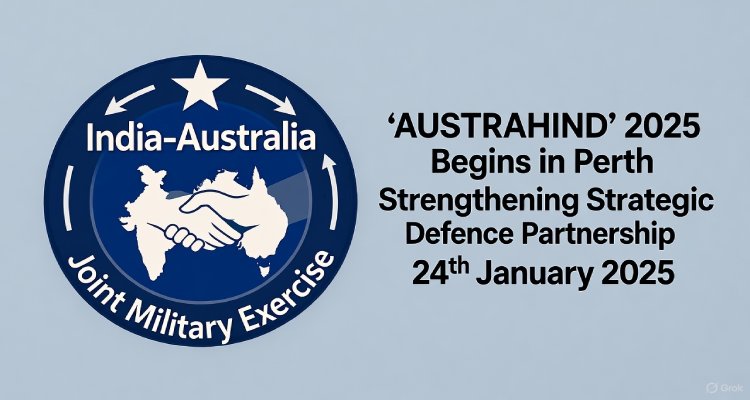India-Australia Joint Military Exercise ‘AUSTRAHIND’ 2025 Begins in Perth, Strengthening Strategic Defence Partnership
The fourth edition of the India-Australia joint military exercise ‘AUSTRAHIND’ began in Perth, focusing on interoperability, counter-terrorism, and tactical coordination between the two nations’ armies.
Introduction: A Symbol of Growing Strategic Trust
India and Australia, two key players in the Indo-Pacific security architecture, have once again joined hands for their annual bilateral military collaboration — Exercise AUSTRAHIND 2025. The fourth edition of this joint exercise commenced on October 13 in Perth, marking another milestone in the strengthening defence partnership between the two democracies.
Scheduled to conclude on October 26, the exercise underscores the shared vision of both nations to deepen defence cooperation, enhance interoperability, and refine tactical operations in complex terrains — from urban landscapes to semi-desert battlefields.
Context & Background: From Rajasthan to Perth
The AUSTRAHIND exercise, which alternates annually between India and Australia, was first held in Mahajan, Rajasthan, in 2022. Since then, it has evolved into a key military engagement aimed at fostering operational synergy between the Indian Army and the Australian Defence Force (ADF).
For this year’s edition, India has deployed a contingent of 120 personnel, led by a Battalion of the Gorkha Rifles, along with troops from various arms and services. The Gorkhas — known for their bravery, discipline, and adaptability — bring valuable experience in counter-insurgency and urban warfare, making them an ideal fit for this high-intensity joint exercise.
Main Developments: Tactical Drills in a Realistic Environment
The ongoing exercise focuses on joint company-level operations in open and semi-desert terrain. Troops are engaging in missions involving:
- Joint planning and coordination
- Tactical drills for counter-terrorism and sub-conventional warfare
- Integration of special arms and emerging defence technologies
AUSTRAHIND offers a realistic platform for both armies to exchange best practices and develop shared operational strategies. The emphasis on urban and semi-urban warfare reflects the evolving nature of modern conflicts, where hybrid threats demand precision, flexibility, and seamless coordination among allies.
Beyond tactical synergy, the exercise aims to bolster mutual understanding, build camaraderie, and enhance the spirit of jointness between the two forces — essential traits in times of global uncertainty.
Expert Insights: Strengthening the Indo-Pacific Defence Web
Defence analysts view AUSTRAHIND as more than just a military drill — it’s a strategic signal.
According to retired Indian Army officer Lt. Gen. Rakesh Mehta (Retd), “Exercises like AUSTRAHIND reflect how India and Australia are moving beyond traditional diplomacy. The focus now is on operational integration, interoperability, and readiness for joint responses to regional security challenges.”
Australia’s increasing participation in Indian-led and multilateral exercises demonstrates its intent to play a larger role in the Indo-Pacific, aligning with India’s “Act East” policy. Both nations share concerns over maritime security, terrorism, and the balance of power in the region — especially amid China’s expanding military influence.
Beyond AUSTRAHIND: A Broader Defence Collaboration
The India-Australia defence relationship has expanded steadily over the past decade through multiple joint exercises across domains:
- AUSINDEX (2015–Present): A bilateral maritime exercise conducted in Visakhapatnam and the Bay of Bengal.
- Exercise MILAN: The Royal Australian Navy has participated in this multilateral event since 2003.
- Exercise KAKADU (2018, 2022, 2024): Indian naval participation in Australia’s biennial multinational maritime exercise.
- Exercise PITCH BLACK (2018, 2022, 2024): A major air combat exercise involving the Indian Air Force.
- Exercise MALABAR (2020–2023): Australia’s inclusion in this quadrilateral naval exercise with India, Japan, and the US marked a major step toward the strengthening of the Quad alliance.
These joint engagements illustrate how India and Australia are transitioning from bilateral partners to strategic allies within a broader Indo-Pacific framework.
Impact & Implications: Reinforcing the Indo-Pacific Order
The continuation of AUSTRAHIND and similar defence collaborations has far-reaching implications:
- Enhanced Military Readiness: Joint training fosters a deeper understanding of each other’s operational doctrines and technologies.
- Regional Stability: The exercise serves as a deterrent against coercive tactics in the Indo-Pacific, reinforcing collective security.
- Technology Integration: Exposure to advanced Australian defence systems and Indian tactical adaptability strengthens both forces.
- Diplomatic Significance: It underlines the growing defence diplomacy between two major democracies aligned on freedom of navigation and rules-based order.
As the world witnesses increasing volatility in the Indo-Pacific — from maritime disputes to hybrid warfare threats — the India-Australia partnership becomes crucial to maintaining peace, stability, and freedom of movement in the region.
Conclusion: Building Trust Through Shared Action
Exercise AUSTRAHIND 2025 stands as a testament to the deepening trust and shared strategic vision between India and Australia. It not only sharpens military capability but also strengthens the emotional and professional bonds between soldiers from both nations.
As both countries continue to align on defence, technology, and regional security, this collaboration will likely evolve into comprehensive joint readiness, vital for navigating the complex geopolitics of the Indo-Pacific.
In a world increasingly defined by alliances and deterrence, AUSTRAHIND is more than a military exercise — it’s a commitment to a shared future of security, cooperation, and mutual respect.
Disclaimer:This article is based solely on publicly available official information and is intended for educational and journalistic purposes.










